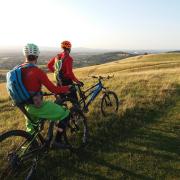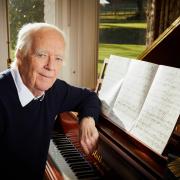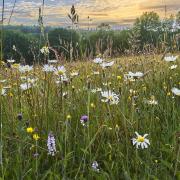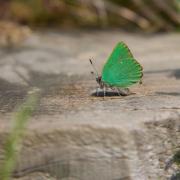Biographer Conor Mark Jameson has been following the Cotswold trail of the once-acclaimed naturalist and author WH Hudson
In the words of war poet Edward Thomas, fellow writer William Henry Hudson (1841-1922) ‘did an eccentric thing for an English naturalist – he was born in South America’. In fact, Hudson lived on the pampas of Argentina until the age of 32, not setting foot in Britain until May 1874. The unschooled immigrant settled – a little uncomfortably – in London, to try to make a living. His early years here are known to have been difficult but are shrouded in mystery. From surviving letters it has emerged that Hudson made an early visit to the Cotswolds within weeks of his arrival. He had come with a few addresses in his notebook, and invitations to visit relatives of family friends at Malmesbury.
He didn’t record much about this at the time, but in 1908, three decades after his first visit, Hudson was recording most things and was back at Malmesbury visiting the church. ‘Climbing to the roof just now I saw five miles away the very tall and very thin spire of Tetbury Church,’ he wrote to a friend. He could reflect on how different his life looked now that he was established, with a civil list pension and British citizenship. He called this quiet corner of the Cotswolds ‘a place of memories for me – it was there I went on first coming to England on a visit to the family of a S. American friend of mine … a very fine fellow who took to drink and went to the dogs. After long years I feel inclined to cycle over and look up these old friends or shed a tear over their ashes if they are all dead.’
By this time Hudson was confirmed as an author of great renown – hence the pension. He was writing what would come to be regarded as one of his classic books, A Shepherd’s Life, embedded in the local shepherding community of an ‘out of the world’ Wiltshire village. This curious outsider had a winning way with everyday people and soon won their trust and respect. His interest in them was sincere, and had an anthropological angle – he saw the natives here ‘through half-foreign eyes’.
When it was published in 1910, A Shepherd’s Life was widely acclaimed and is among the most enduring of Hudson’s works, being still in print. A friend sent me a photograph of it on the shelves of Waterstone’s next to a Richard Jefferies title, with a book of my own sandwiched between. I found this both humbling and embarrassing, but I’ve dined out on the story nonetheless, and alphabetical order counts for something, I have assured myself.
Hudson had other literary connections here. In 1895 he visited his author friend Algernon Gissing, who lived at Broadway, and would later publish The Footpath Way in North Gloucestershire, one of the first walking guides for the Cotswolds, and perhaps the best known of Gissing’s 20 books. Popular as this book was, life could be hard for a writer with such a local focus, and Hudson, who had known extreme hardship for a decade or more after his arrival in London, was a great help to his friend, helping him receive support from the Royal Literary Fund.
Hudson was especially fond of Bath, and returned many times. In early 1899 he stayed for at least five weeks, and wrote many letters from there, and more expansively about it in his 1909 book Afoot in England.

Hudson was helped to get to know this part of the world in the Edwardian era by his unlikely close friend Margaret Brooke, the celebrated Ranee of Sarawak. Her by now estranged husband the Rajah had his British base at Chesterton House, near Cirencester. Hudson had earned a reputation for being something of a recluse where celebrities and the ruling classes were concerned, and would often excuse himself from meetings in high places. Brooke overcame his resistance through the sheer force and colour of her personality. She ‘collected’ artists, musicians and writers, and adopted Hudson as her favourite author. They bonded through their exotic backgrounds and a shared love of birds, music and literature, and remained devoted friends for life.
With his growing renown, Hudson had also become a popular subject for the portrait and landscape painter William Rothenstein, whose success and fondness for the Cotswolds led to him buying a farmhouse at Far Oakridge, near Stroud.
Notwithstanding his friendship with Ranee Margaret, and even Foreign Secretary Sir Edward Grey (who was a huge fan), Hudson retained a degree of shyness around big names. However, through Rothenstein he met a number of prominent figures of the era, including T.E. Lawrence ‘of Arabia’ and the Nobel Prize-winning Indian poet Rabindranath Tagore, who sat to have his portrait painted during a visit to Britain in 1912. It seems likely that it was at Oakridge that Hudson came to meet him, for it was Hudson that Tagore most wanted to meet. Rothenstein’s salons in Hampstead were still just a little too crowded for ‘old Huddy,’ even if W.B. Yeats, George Bernard Shaw and others were present. In truth, Hudson was now feeling his age, and a constitution that had always been fragile, despite his sometimes extraordinary feats of rambling and cycling in pursuit of nature.

When World War broke out in 1914, it was announced to the nation by a sombre Edward Grey. ‘The lamps are going out,’ he famously said. While Hudson tried to appear sanguine, sheltering at Ranee Margaret’s country house at Ascot, his hostess was becoming a little frantic. She called the war a ‘dire catastrophe’, and retreated to her estranged husband the Rajah’s Cotswold house, in case of an enemy invasion and to put more miles between herself and the south-east coast where they might be expected to land. But the manoeuvre didn’t ease her anxieties, and she found Chesterton House lacking in a few home comforts, such as curtains. Her daughter-in-law Sylvia Brett, who succeeded her as Ranee of Sarawak, recalled the house’s interior: ‘foxes’ heads, brushes, whips, spurs and hunting horns were everywhere. The whole place seemed to smell of bran and oats’.
Ranee Margaret’s ageing husband was also by now in need of support, as his beloved Sarawak’s future was in great peril, and his son and heir Vyner must be made ready to take the reins, assuming he could safely travel halfway round the world to get there. Ranee Margaret’s two younger sons enlisted in the army, one being posted to Egypt. ‘The old Rajah is half crazy about the war’, Hudson reported to friends at the time.
I was surprised to discover in one of Hudson’s letters that Society for the Protection of Birds (later Royal) founder Eliza Phillips, now frail and in her nineties, was staying with her at Cirencester. The RSPB was founded entirely by women, but one man was present from the very first meeting – Hudson. Ranee Margaret was a loyal patron, and helped with measures to curtail the plumage trade from Borneo, of which Sarawak was a vast kingdom gifted to the Brooke family by the Sultan of Brunei.

By the end of the war the old Rajah was dead, and so too was Edward Thomas, Hudson’s dear young friend – like the son Hudson never had – killed on the western front in spring 1917. Hudson had survived his own brush with serious illness, and the flu pandemic that swept the world as the war ended. He wrote a memoir of childhood, prompted by visions of his pampas past, and, sensing his days were numbered, worked frantically to finish several other books and new editions of previous work packaged for the US market, which had belatedly discovered him. He amassed as much money as he could, not for himself, but to leave to conservation, through his beloved ‘Bird Society’.
A memorial sculpture and bird sanctuary in Hyde Park are dedicated to Hudson’s memory, such was the affection in which he had come to be held by the end of his life, a century ago.
Finding WH Hudson, by Conor Mark Jameson, is published by Pelagic, pelagicpublishing.com



























